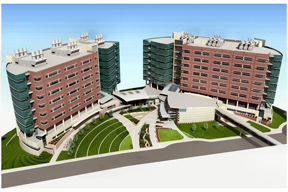 UNMC will seek approval of the University of Nebraska Board of Regents Friday to proceed with construction of a second research tower.
UNMC will seek approval of the University of Nebraska Board of Regents Friday to proceed with construction of a second research tower.
The 10-level facility, which is presently being called the Research Center of Excellence II, would be nearly identical to the Durham Research Center, which opened in 2003. It would contain 252,179 gross square feet with 98 state-of-the-art laboratories as well as office space for investigators and laboratory support space.
It would be located only a few yards south of the Durham Research Center on the northwest corner of Durham Research Plaza (formerly 45th Street) and Emile Street. The two research towers will be connected with a covered passageway.
With approval of the regents to begin construction, UNMC is likely to break ground late this summer or early this fall. The building would be completed by the winter of 2008.
“The new research tower represents the next piece of the puzzle in UNMC’s quest to become a world-class academic health science center,” said UNMC Chancellor Harold M. Maurer, M.D. “Over the past decade, we’ve improved our facilities tremendously by adding new clinical and research buildings and by beginning construction on our new education building. Research is the one area that can have the most impact on the citizens of Nebraska – both in terms of medical breakthroughs and on the state’s economic development. The new research tower will truly take us to another level.”
The second tower is needed, Dr. Maurer said, to sustain UNMC’s momentum in increasing its research funding. Over the past 10 years, annual research funding has nearly tripled going from $25.1 million in 1996 to $74 million today. One of UNMC’s stretch goals is to reach $200 million by the end of 2009.
A key component of reaching that goal is recruiting scientists who already are funded through agencies such as the National Institutes of Health, said Tom Rosenquist, Ph.D., vice chancellor for research at UNMC.
“Certainly, a second research tower will be a significant tool in recruiting talented medical scientists, which is necessary if we are to reach our goals,” Dr. Rosenquist said. “The outstanding, 21st-century research environment provided by the Durham Research Center has been a key to the outstanding increase in the size, scope and quality of UNMC research.
“The scientists in the DRC have won grants and contracts whose total dollar value already exceeds the cost of the building. The impact of these funds upon the economy of Omaha and Nebraska has been enormous, and the impact of this research upon the reputation of UNMC and the University of Nebraska is inestimable. The DRC is full and is operating at near capacity. Our completion of the second research tower will facilitate continued growth of UNMC research, to the continuing benefit of our community and state.”
UNMC hopes to reach the $100 million plateau in research in the next year or two, Dr. Rosenquist said. “This is an important target goal,” he said. “Once an academic health science center reaches the $100 million mark, it becomes much easier for research to become self-sustaining.”
He added that UNMC has 24 departments conducting research, and he has challenged each department to increase its research by aggressively going after grants or by adding new scientists with existing grants.
Research activities within the second research tower will be multidisciplinary, grouped around UNMC priority areas, including cancer, biosecurity, cardiovascular diseases, gastrointestinal and liver diseases, developmental biology, genetics and molecular genetics, neurobiology, and organ transplantation biology.
Most of the 98 laboratories would be dedicated to research in the College of Medicine, the Eppley Cancer Center, the College of Pharmacy, and to support the operations of the Nebraska Public Health Laboratory and the University of Nebraska Center for Biosecurity to advance Nebraska’s efforts in bioterrorism preparedness.
The second research tower would improve the health and biosecurity of Nebraskans by providing additional infrastructure for biomedical research and biosecurity preparedness, Dr. Maurer said.
“The building is essential to further elevate Nebraska’s national presence in biosecurity,” he said.
As with the Durham Research Center, funding for the $74 million second research tower will come primarily from private fundraising efforts.
 |
The Research Center for Excellence II, shown on the left, would be only a few yards south of the Durham Research Center, which opened in 2003. |